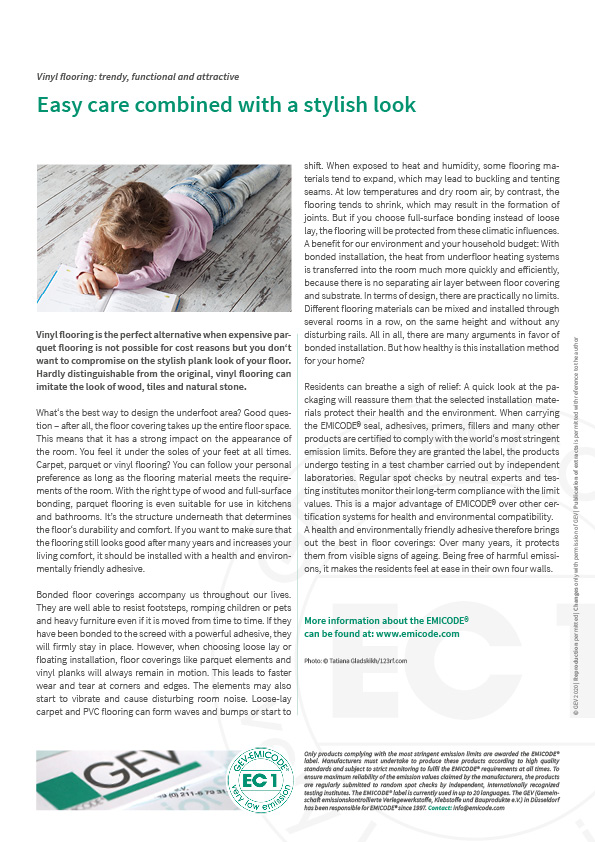Easy care combined with a stylish look
Vinyl flooring: trendy, functional and attractive
What’s the best way to design the underfoot area? Good question – after all, the floor covering takes up the entire floor space. This means that it has a strong impact on the appearance of the room. You feel it under the soles of your feet at all times. Carpet, parquet or vinyl flooring? You can follow your personal preference as long as the flooring material meets the requirements of the room. With the right type of wood and full-surface bonding, parquet flooring is even suitable for use in kitchens and bathrooms. It’s the structure underneath that determines the floor’s durability and comfort. If you want to make sure that the flooring still looks good after many years and increases your living comfort, it should be installed with a health and environmentally friendly adhesive.
Bonded floor coverings accompany us throughout our lives. They are well able to resist footsteps, romping children or pets and heavy furniture even if it is moved from time to time. If they have been bonded to the screed with a powerful adhesive, they will firmly stay in place. However, when choosing loose lay or floating installation, floor coverings like parquet elements and vinyl planks will always remain in motion. This leads to faster wear and tear at corners and edges. The elements may also start to vibrate and cause disturbing room noise. Loose-lay carpet and PVC flooring can form waves and bumps or start to shift. When exposed to heat and humidity, some flooring materials tend to expand, which may lead to buckling and tenting seams. At low temperatures and dry room air, by contrast, the flooring tends to shrink, which may result in the formation of joints. But if you choose full-surface bonding instead of loose lay, the flooring will be protected from these climatic influences.
A benefit for our environment and your household budget: With bonded installation, the heat from underfloor heating systems is transferred into the room much more quickly and efficiently, because there is no separating air layer between floor covering and substrate. In terms of design, there are practically no limits. Different flooring materials can be mixed and installed through several rooms in a row, on the same height and without any disturbing rails. All in all, there are many arguments in favor of bonded installation. But how healthy is this installation method for your home?
Residents can breathe a sigh of relief: A quick look at the packaging will reassure them that the selected installation materials protect their health and the environment. When carrying the EMICODE® seal, adhesives, primers, fillers and many other products are certified to comply with the world’s most stringent emission limits. Before they are granted the label, the products undergo testing in a test chamber carried out by independent laboratories. Regular spot checks by neutral experts and testing institutes monitor their long-term compliance with the limit values. This is a major advantage of EMICODE® over other certification systems for health and environmental compatibility.
A health and environmentally friendly adhesive therefore brings out the best in floor coverings: Over many years, it protects them from visible signs of ageing. Being free of harmful emissions, it makes the residents feel at ease in their own four walls.

Photo: ©Tatiana Gladskikh/123rf.com
Vinyl flooring is the perfect alternative when expensive parquet flooring is not possible for cost reasons but you don’t want to compromise on the stylish plank look of your floor. Hardly distinguishable from the original, vinyl flooring can imitate the look of wood, tiles and natural stone.

Do You Have Questions?
If you have questions about specific topics or if you would like to contact us for any other reason, feel free to contact us by phone, fax or e-mail.
Phone: +49 211 / 67931-20
Fax: +49 211 / 67931-33
info@emicode.com
Share article on Social Media: